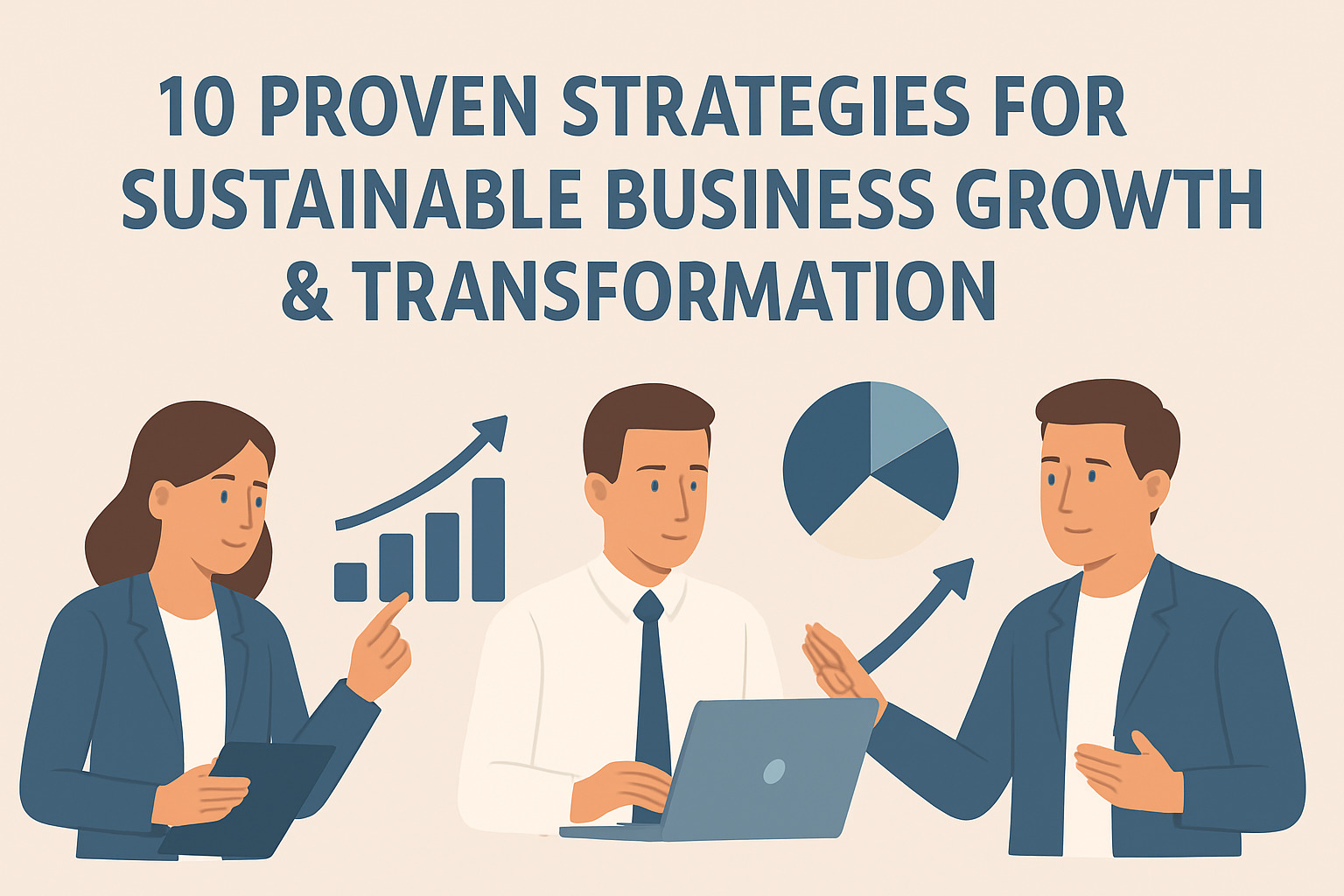
In today’s fast-changing business landscape, growth is not just about scaling revenue; it’s about transformation. Companies that thrive in the long term don’t just grow; they evolve, innovate, and adapt. Sustainable business growth & transformation means aligning your strategy, people, and operations to achieve consistent success, even in uncertainty.
This blog will explore 10 actionable, evidence-based strategies that empower entrepreneurs, leaders, and organizations to accelerate growth and lead lasting transformation while staying true to their purpose.
1. Define a Clear Vision with Measurable Outcomes
Every successful transformation starts with clarity. Your business vision acts as your North Star it aligns your team, shapes your culture, and fuels your strategy. Without a clear vision, growth becomes reactive rather than intentional.
Here’s how to refine your vision:
- Articulate a specific, measurable goal for the next 3–5 years.
- Ensure it aligns with your core mission and customer value.
- Break the vision down into quarterly milestones.
- Communicate it consistently across all departments.
When everyone understands the “why” behind the work, your business growth & transformation strategy becomes unstoppable.
2. Develop a Scalable Business Model
A scalable business model is the backbone of sustainable growth. It allows your organization to expand without exponentially increasing costs or complexity.
To build scalability:
- Automate repetitive processes through technology and AI-driven tools.
- Standardize your operations so new markets or locations can be added easily.
- Focus on recurring revenue streams like subscriptions or long-term service contracts.
Scalability isn’t about doing more; it’s about doing smarter. When your model is designed to grow, every new customer or opportunity amplifies results.
3. Prioritize Customer-Centric Transformation
In the age of personalization, growth depends on how well you understand your customers. Businesses that transform around customer needs outperform competitors who focus solely on profit.
Practical steps to build a customer-first culture:
- Use feedback loops to continuously improve offerings.
- Leverage data analytics to predict behaviors and personalize experiences.
- Empower frontline teams to make decisions that enhance customer satisfaction.
Customer-centric transformation ensures loyalty, advocacy, and long-term brand equity—three essentials for sustained growth.
4. Invest in Leadership Development
No business grows beyond its leadership capacity. Transformative growth requires leaders who can inspire teams, make data-driven decisions, and adapt under pressure.
Investing in leadership programs, such as business growth & transformation, equips executives with frameworks for strategy, communication, and innovation. Strong leaders create alignment, accountability, and momentum, turning transformation from an abstract idea into measurable progress.
Leadership isn’t a title; it’s the engine of every successful transformation.
5. Build Agility into Your Strategy
Traditional business plans are static; today’s economy demands agility. Business agility allows you to respond quickly to market shifts without losing focus on your mission.
To build an agile organization:
- Adopt short planning cycles (quarterly sprints).
- Encourage cross-functional collaboration to reduce silos.
- Continuously analyze data and adjust direction when necessary.
Agility isn’t chaos—it’s flexibility with discipline. Businesses that adapt fast don’t just survive, they set the pace for everyone else.
6. Strengthen Operational Excellence
Operational excellence turns strategy into execution. It’s about aligning processes, people, and technology for consistent performance.
Key pillars include:
- Lean management practices to minimize waste and boost productivity.
- Data-driven decision-making for performance tracking.
- Standard operating procedures (SOPs) for efficiency and consistency.
Transformation without operational discipline leads to burnout and bottlenecks. Excellence ensures growth is not just achieved but sustained.
7. Embrace Digital Transformation
Digital transformation is no longer optional—it’s essential. From automation to cloud collaboration, digital tools streamline operations and open new opportunities for innovation.
Ways to embrace digital growth:
- Use AI to enhance customer experiences and data analytics.
- Migrate to cloud-based platforms for scalability and security.
- Leverage digital marketing for measurable, targeted outreach.
Businesses that integrate digital transformation experience faster scaling, deeper customer engagement, and greater resilience against disruption.
8. Build a Culture of Innovation
Sustainable business growth & transformation requires a culture that rewards creativity, experimentation, and learning from failure.
To cultivate innovation:
- Encourage team brainstorming sessions and intrapreneurship.
- Reward new ideas, even if they fail the first time.
- Allocate resources for research, pilot projects, and skill-building.
When innovation becomes part of your DNA, transformation becomes continuous, not occasional. The best companies innovate not because they have to—but because they can.
9. Optimize Financial Strategy for Growth
Healthy finances are the foundation of business expansion. But transformation also demands strategic reinvestment—knowing where to allocate resources for maximum impact.
Consider these financial growth tactics:
- Reinvest profits into high-ROI initiatives like technology or leadership.
- Maintain a balance between cost efficiency and value creation.
- Diversify income streams to reduce dependency on one market.
Smart financial management ensures that every growth decision strengthens, not strains your business ecosystem.
10. Measure, Learn, and Evolve
Transformation is never a one-time event—it’s a cycle of measuring, learning, and improving. Businesses that thrive treat metrics as mirrors, not scorecards.
Effective measurement involves:
- Tracking KPIs that align with your vision.
- Conducting regular performance reviews and audits.
- Adjusting strategies based on insights—not assumptions.
Evolution is the hallmark of sustainable success. The moment a company stops learning, it stops growing.
Integrating Growth & Transformation: The Winning Formula
True business growth & transformation are inseparable. Growth expands your reach; transformation strengthens your foundation. Together, they create resilience—the ability to scale sustainably in uncertain markets.
Think of it as a three-layer formula:
- Vision (Direction): Defines where you’re headed.
- Systems (Structure): Provides the framework to scale.
- Culture (Energy): Fuels long-term motivation and performance.
Without vision, growth is blind. Without systems, it’s chaotic. Without culture, it’s temporary. The most successful companies align all three to build an ecosystem that evolves naturally.
How to Start Your Business Transformation Journey
Getting started doesn’t require a massive overhaul—it starts with intention.
Here’s a step-by-step roadmap:
- Assess where your business stands today.
- Identify key areas for improvement: leadership, operations, or digital strategy.
- Set measurable goals for the next 12 months.
- Enroll in a trusted Business Growth Course to gain proven frameworks.
- Implement, measure, and refine continuously.
Transformation is not about doing everything at once; it’s about doing the right things consistently.
The Power of Mindset in Growth
Behind every thriving organization is a mindset of continuous improvement. Leaders who embrace change, stay curious, and remain open to feedback drive evolution faster than those who resist it.
A transformative mindset shifts your focus from “What do we need to fix?” to “What can we create next?” It replaces fear with innovation and limitation with potential.
Transformation starts with systems—but it succeeds with mindset.
Sustainability: The True Measure of Success
Sustainability isn’t just about environmental impact—it’s about lasting relevance. A business that grows sustainably maintains profitability while protecting its people, processes, and purpose.
Core elements of sustainable growth include:
- Ethical leadership and transparent communication.
- Continuous skill development across teams.
- Smart use of data and technology to minimize waste.
The companies that last are those that build for tomorrow—today.
Conclusion: Transform Today, Thrive Tomorrow
Growth is easy to start but hard to sustain. Transformation ensures that the Business Growth Course doesn’t fade with market trends; it compounds over time.
By applying these 10 proven strategies, you can create a business that not only scales revenue but also evolves in purpose, efficiency, and innovation.
The journey of business growth & transformation begins with a single step—the decision to change how you lead, operate, and adapt.
FAQs
- What is the difference between business growth and business transformation?
Business growth focuses on expanding revenue, market share, and customer base, while business transformation involves fundamentally rethinking operations, strategy, and culture to sustain long-term success. Growth is about scale transformation is about evolution.
- How can small businesses achieve sustainable business growth & transformation?
Small businesses can start by setting clear goals, streamlining operations, embracing digital tools, and investing in leadership development. Even small, consistent improvements—guided by a structured Business Growth Course—can create lasting transformation.
- Why is leadership development critical for business transformation?
Leadership drives culture, strategy, and decision-making. Without skilled, growth-minded leaders, even the best plans fail. Investing in leadership training helps teams align with vision, stay agile, and execute transformative change effectively.
- What role does digital transformation play in business growth?
Digital transformation enables efficiency, automation, and better decision-making through data insights. It empowers businesses to innovate faster, reach wider audiences, and adapt quickly to changing markets—key factors for sustainable business growth & transformation.
- How do I know if my business is ready for transformation?
Your business is ready for transformation when you’ve hit a growth plateau, face operational inefficiencies, or see new market opportunities that your current model can’t support. Assessing your readiness through a professional Business Growth Course can help identify the right next steps.







